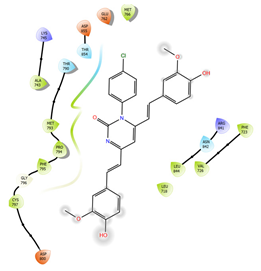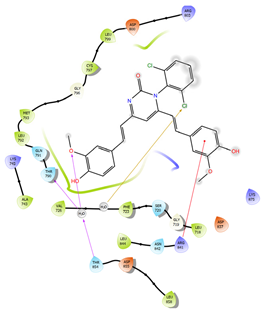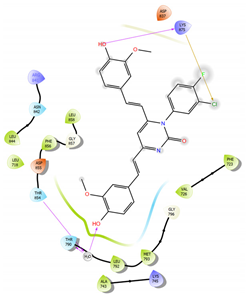Abstract
Natural products (NPs) continue to provide a structural template for the design of novel therapeutic agents and expedite the drug discovery process. The majority of FDA-approved pharmaceuticals used in medical practice can be traced back to natural sources, and NPs play a significant role in drug development. Curcumin, one of the most well-studied chemicals among the NPs, is currently the subject of intense investigation for its biological effects, including the prevention and treatment of cancer. Cancer has overtaken all other causes of death in the world today, with 19.3 million new cases and nearly 10 million deaths predicted in 2020. In the present investigation, we reported the synthesis of three semi-synthetic analogues of curcumin-bearing pyrimidinone moiety by the chemical modification of the diketone function of curcumin followed by their characterization by analytical techniques including infrared (IR), nuclear magnetic resonance (NMR), and mass spectral data. According to the National Cancer Institute (NCI US) methodology, the curcumin analogues (C1-C3) were tested for their anticancer efficacy against 59 cancer cell lines in a single dose assay. 1-(2,6-Dichlorophenyl)-4,6-bis((E)-4-hydroxy-3-methoxystyryl)pyrimidin-2(1H)-one (C2) demonstrated the most promising anticancer activity with mean percent growth inhibition (%GIs) of 68.22 in single dose assay at 10 µM. The compound exhibited >68 %GIs against 31 out of 59 cancer cell lines and was found to be highly active against all leukemia and breast cancer cell lines. The compound C2 showed a lethal effect on HT29 (colon cancer) with %GI of 130.44, while 99.44 %GI was observed against RPMI-8226 (Leukemia). The compound C2 displayed better anticancer activity against the panels of CNS, melanoma, ovarian, prostate, and breast cancer cell lines than curcumin and other anti-EGFR agents gefitinib and imatinib in single dose assay. The compound C2 also demonstrated potent anticancer activity in a 5-dose assay (0.001 to 100 µM) with GI50 values ranging from 1.31 to 4.68 µM; however, it was found to be non-selective with SR values ranging from 0.73 to 1.35. The GI50 values of compound C2 were found to be better than that of the curcumin against all nine panels of cancer cell lines. All of the curcumin analogues were subsequently investigated for molecular docking simulation against EGFR, one of the most attractive targets for antiproliferative action. In molecular docking studies, all the ligands were found to accommodate the active site of EGFR and the binding affinity of ligand C2 was found to be −5.086 kcal/mol. The ligand C2 exhibited three different types of interactions: H-bond (Thr790 and Thr854), π-cationic (Arg841), and aromatic H-bond (Asn842). The curcumin analogues reported in the current investigation may provide valuable therapeutic intervention for the prevention and treatment of cancer and accelerate anticancer drug discovery programs in the future.
1. Introduction
Currently, a major challenge facing the modern scientific community is the development of novel anticancer drugs with fewer side effects. Research on natural products (NPs) has been boosted recently because NPs are thought to be relatively safer than synthetic ones [1,2]. The use of NPs for medicinal purposes has gained popularity during the past few decades. Many of the FDA-approved medications used in clinical practices came from natural sources [3,4]. Many anticancer agents have been obtained by the chemical modification of NPs. A few examples of such modifications are given in Figure 1 [5,6,7,8,9,10,11,12,13,14]. Similarly, curcumin, one of the key chemical components found in turmeric (Curcuma longa Linn.), has been utilized to prepare a variety of semi-synthetic analogues [15,16,17,18,19,20,21,22]. Medicinal chemists have identified four main sites to bring about chemical modification in curcumin to form semi-synthetic congeners, including active methylene (-CH2-), aryl side chain, diketone group, and carbon-carbon double bonds (-CH=CH-) with improved bioactivity [23,24]. In the current study, we described the chemical modification of the diketone function of curcumin into their pyrimidine analogues as well as their antiproliferative activity. The chemical modification is outlined in Figure 2. The structural alteration was found to enhance biological activities by enhancing stability, reducing rotational freedom, and diminishing metal-chelation characteristics [25]. Our research team found that curcumin analogues have been demonstrated to have anticancer, antimalarial, and anti-HIV effects in the past [26,27,28]. Numerous biological activities, such as those that are antibacterial, anticancer, antioxidant, antimalarial, anti-inflammatory, anti-Alzheimer’s, and anti-HIV, have been reported [15,16,17,18,19,20].
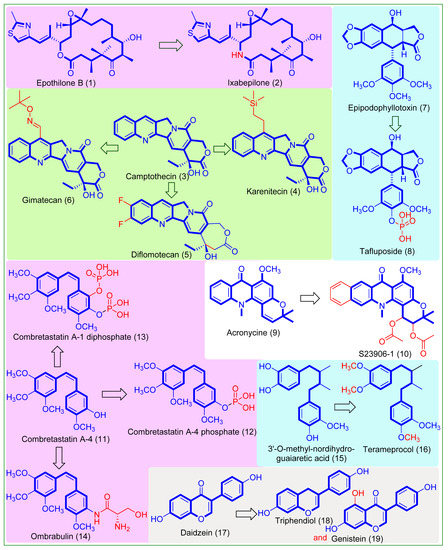
Figure 1.
Anticancer drugs derived from natural products [NPs; epothilone B (1), camptothecin (3), epipodophyllotoxin (7), acronycine (9), combretastatin A-4 (11), 3’-O-methylnordihydroguaiaretic acid (15), and daidzein (17)] by chemical modification.

Figure 2.
Structural modification of diketone function into pyrimidinone.
Cancer has overtaken all other causes of death in the world today, with 19.3 million new cases and nearly 10 million deaths predicted in 2020 [29]. Nowadays, systemic chemotherapy is used in conjunction with large-mass surgical excision of the tumor and radiation therapy. Chemotherapy often associated with numerous toxic effects and scientists from all over the world are working to find safer cancer treatments. As active ingredients derived from natural sources were presumed to be safe, our reliance on nature increased. The majority of anticancer drugs today in clinical practices are from natural sources [4,30]. The epidermal growth factor receptor (EGFR) is found on the surface of some normal cells and is involved in cell growth. The EGFR protein participates in cell signaling pathways that regulate cell survival and division. Sometimes, mutations in the EGFR gene cause EGFR proteins to be made in higher than normal amounts in a number of cancer cell lines, including those from breast, colon, non-small cell lung, renal, melanoma, ovarian, and prostate cancers. This causes cancer cells to divide more rapidly [31,32,33,34,35]. Curcumin analogues have also been identified as EGFR inhibitors, hence we selected EGFR as a potential target for molecular docking studies [2,22,26]. We examine the binding insight of curcumin analogues against the active site since it is a rational target for several anticancer treatments (such as Gefitinib, Erlotinib, Cetuximab, Panitumumab, and others) as well as the most widely researched receptor in the tyrosine kinase superfamily [36,37,38,39].
2. Results
2.1. Isolation of Curcumin
Curcumin was isolated by a conventional method as per the reported procedure and nearly 250 mg of curcumin was isolated with 80 g of the ground tumeric powder [2,40].
2.2. Chemistry
Preparation of 1-aryl-4,6-bis((E)-4-hydroxy-3-methoxystyryl)pyrimidin-2(1H)-one (C1-C3)
The curcumin analogues (C1-C3) bearing pyrimidinone moiety were synthesized by conventional heating method and the synthetic protocol is summarized in Scheme 1. A mixture of isolated curcumin (A1) (0.20 mmol; 73.6 mg) and substituted phenyl urea (B1-B3) (0.20 mmol) in glacial acetic acid (10 mL) was stirred in a sandbath at 80 °C for 8 h. The reaction mixture was then concentrated and poured into the crushed ice to obtain crude final products (C1-C3). The crude product was then re-crystallized with ethanol to obtain 1-substitutedphenyl-4,6-bis((E)-4-hydroxy-3-methoxystyryl)pyrimidin-2(1H)-one (C1-C3). The completion of the reaction was monitored throughout by preparatory thin layer chromatography (TLC Silica gel 60 F254) in the mobile phase n-hexane: ethylacetate (6: 4). The substituted phenyl urea ((B1-B3) was prepared as per the reported method [41,42]. Curcumin exhibits tautomeric isomerism viz. keto and enol form (Part A). The formation of curcumin is supposed to be accomplished in two steps as shown in Scheme 2 (Part B).

Scheme 1.
Protocol for the synthesis of semi-synthetic curcumin analogues (C1-C3).
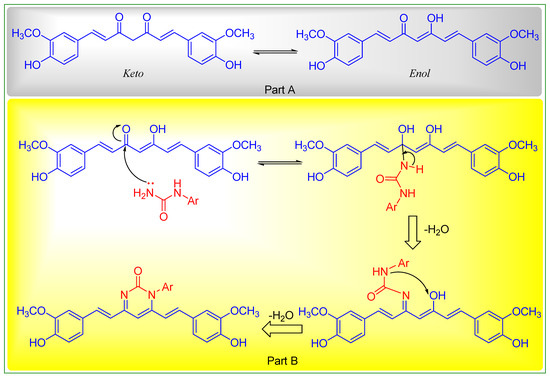
Scheme 2.
The reaction mechanism for the synthesis of curcumin analogues (C1-C3).
2.3. Antiproliferative Activity
The anticancer activity of the curcumin analogues (C1-C3) was carried out against 60 NCI cancer cell lines derived from nine different panels (breast, colon, CNS, leukemia, melanoma, non-small cell lung, ovarian, renal, and prostate cancer cell lines) at a single dose (10 µM) and five dose assay as per the National Cancer Institute US [43,44,45,46]. The results of anticancer activity of compounds C1-C3 in single dose assay at 10 µM are given in the Table 1 (Figures S1–S3). The compound C1 displayed more than 50 to 67 percent growth inhibitions (% GIs) against three leukemia cancer cell lines (SR, MOLT-4, and CCRF-CEM) with %GIs of 63.58, 57.03, and 55.82 respectively, and one breast cancer cell line MCF7 (%GIs of 52.38). The compound C1 showed moderate anticancer activity with %GI of 20–50 against 16 cancer cell lines HCT116 (%GI = 49.42), MDA-MB-231 (%GI = 39.69), LOX IMVI (%GI = 38.43), RPMI-8226 (%GI = 35.53), UO-31 (%GI = 35.12), BT-549 (%GI = 33.10), SNB-75 (%GI = 30.28), PC-3 (%GI = 27.72), MDA-MB-435 (%GI = 25.07), U251 (%GI = 24.47), SF-268 (%GI = 23.95), MDA-MB-468 (%GI = 23.56), KM12 (%GI = 23.01), SF-539 (%GI = 21.92), EKVX (%GI = 21.89), and OVCAR-4 (%GI = 21.66), while showed less activity against rest of the 37 cancer cell lines. The compound C1 displayed the most promising anticancer activity against IGROV1 with %GI of 91.43. The compound C1 displayed significant anticancer activity against the colon cancer cell line HT29 with %GI of 55.65, while displayed 40–50 %GIs against four cancer cell lines viz. NCI-H522 (%GI = 48.31), MOLT-4 (%GI = 47.47), RPMI-8226 (%GI = 44.65), and CCRF-CEM (%GI = 44.43). The compound C3 displayed 20–40 %GIs against 12 cancer cell lines, HCT-116 (%GI = 38.73), MDA-MB-231 (%GI = 34.16), MCF7 (%GI = 32.66), SR (%GI = 32.20), UACC-257 (%GI = 32.02), U251 (%GI = 27.95), UO-31 (%GI = 27.54), K-562 (%GI = 25.32), UACC-62 (%GI = 24.86), SN-12C (%GI = 23.96), LOX IMVI (%GI = 21.97), and A529 (%GI = 21.87), while it displayed less activity against the rest of the 42 cancer cell lines. The compounds C1 and C2 displayed lethal effects on the colon cancer cell line HT29 with %GI of 105.09 and 130.44 respectively. The compound C2 displayed the most promising anticancer activity among the series. The compound C2 displayed 50–67 %GIs against 11 cancer cell lines IGROV1 (%GI = 66.54), SNB-19 (%GI = 65.86), PC-3 (%GI = 65.14), HS-578T (%GI = 63.69), ACHN (%GI = 62.22), UACC-62 (%GI = 61.83), UACC-257 (%GI = 58.9), HCC-2998 (%GI = 58.23), A549 (%GI = 55.85), EKVX (%GI = 52.61), SK-OV-3 (%GI = 52.29), SNB-75 (%GI = 51.58), and NCI-H226 (%GI = 51.15), and displayed 20–50 %GIs against HOP-62 (%GI = 49.42), NCI/ADR-RES (%GI = 44.79), OVCAR-4 (%GI = 43.74), OVCAR-5 (%GI = 42.42), M14 (%GI = 42.29), MALME-3M (%GI = 41.21), CAKI-1 (%GI = 36.82), COLO 205 (%GI = 29.19), NCI-H460 (%GI = 29.16), NCI-H322M (%GI = 27.35), SF-295 (%GI = 25.63), A498 (%GI = 21.46), and HOP-92 (%GI = 21.31), while displaying less activity with %GIs <20 against 2 cancer cell lines namely SK-MEL-2 (%GI = 17.08) and TK-10 (%GI = 13.98). The compound C2 displayed the most promising anticancer activity with %GIs more >68 against 30 cell lines namely RPMI-8226 (%GI = 99.44), LOX IMVI (%GI = 97.17), SF-539 (%GI = 96.65), SR (%GI = 95.88), MDA-MB-435 (%GI = 95.43), HCT-116 (%GI = 95.37), OVCAR-8 (%GI = 92.47), U251 (%GI = 91.46), K-562 (%GI = 90.79), MOLT-4 (%GI = 90.29), NCI-H522 (%GI = 90.11), HCT-15 (%GI = 89.72), CCRF-CEM (%GI = 89.66), SW-620 (%GI = 89.57), OVCAR-3 (%GI = 89.34), RXF 393 (%GI = 88.18), KM12 (%GI = 87.88), MCF7 (%GI = 86.25), BT-549 (%GI = 84.83), SK-MEL-28 (%GI = 82.41), SF-268 (%GI = 80.15), T-47D (%GI = 75.89), UO-31 (%GI = 74.86), SN 12C (%GI = 72.16), DU-145 (%GI = 71.26), NCI-H23 (%GI = 71.04), MDA-MB-231 (%GI = 71.00), MDA-MB-468 (%GI = 70.41), 786-O (%GI = 70.30), and HL-60(TB) (%GI = 46.47). The anticancer activity of curcumin analogues (C1-C3) is shown in Figure 3. The anticancer activity of curcumin analogues C1-C3 were compared with curcumin and other EGFR inhibitors, Gefitinib and Imatinib, and their comparative anticancer activity at 10 µM is given in Table 2. The mean %GIs of individual panels was calculated from the single dose assay data. The compound C2 displayed better anticancer than curcumin and standard drug imatinib and gefitinib activity against CNS, melanoma, ovarian, prostate, and breast cancer cell lines. The curcumin analogues displayed mean growth percent inhibition of 68.22 (%GI = >68), and were further selected for screening in a 5-dose assay [47].

Table 1.
60 NCI cancer cell lines based antiproliferative activity of curcumin analogues C1-C3 in single dose (10 µM) and 5-dose assay (0.001–100 µM) of curcumin analogue C2.
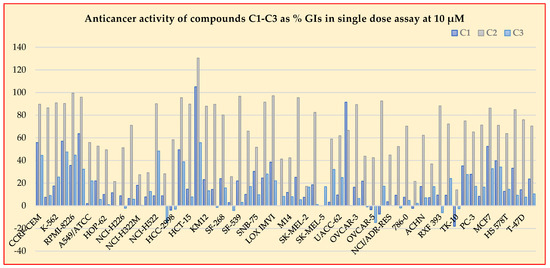
Figure 3.
The percent growth inhibition of compounds C1-C3 in single dose assay against 59 NCI cancer cell lines.

Table 2.
Mean % GI of compounds C1-C3 and curcumin at 10 µM.
The 5-dose assay was carried out as per the reported method [48,49,50]. The compound C2 showed strong antiproliferative activity in a 5-dose assay against 58 NCI cell lines, with GI50 values ranging from 1.31 to 4.68 µM, TGI values ranging from 1.05 to >100 µM, and LC50 values between 6.41 and >100 µM. The compound C2 displayed superior anticancer activity than curcumin in 5-dose assay (Figure 4). The compound C2 displayed the most promising antiproliferative activity against HL-60(TB) (GI50 = 2.64 µM) among leukemia cell lines, NCI-H522 (GI50 = 1.55 µM) among non-small cell lung cancer cell lines, HCT-116 (GI50 = 1.31 µM) among colon cancer cell lines, SF-539 (GI50 = 2.18 µM) among CNS cancer cell lines, MDA-MB-435 (GI50 = 1.63 µM) among melanoma cell lines, OVCAR-5 (GI50 = 2.76 µM) among ovarian cancer cell lines, CAKI-1 (GI50 = 1.46 µM) among renal cell lines, DU-145 (GI50 = 3.68 µM) among prostate cancer cell lines, and MCF7 (GI50 = 2.00 µM) among breast cancer cell lines. The compound C2 exhibited non-selectivity against all the nine panels of cancer cell lines with a selectivity ratio (SR) ranging between 0.73 and 1.35 as the value of SR was found to be less than three (Table 1) [51]. The anticancer activity of compounds C2 against nine panels of 58 NCI cancer cell lines in terms of GP and Log10 molar concentration are shown in Figure 5.
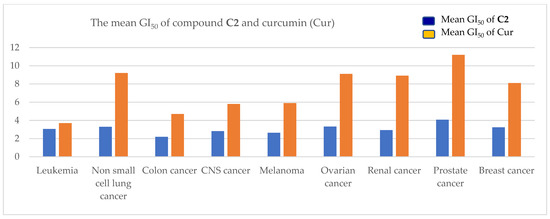
Figure 4.
The mean GI50 for compound C2 and curcumin (Cur) in µM concentration.
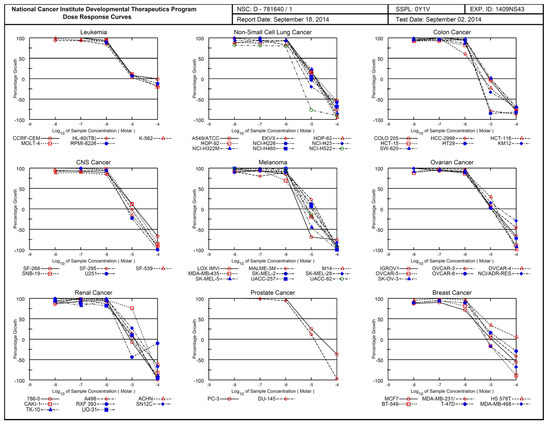
Figure 5.
58 NCI cancer cell lines based anticancer activity of compound C2.
2.4. Molecular Docking Studies
Curcumin and its analogues’ anti-EGFR action were well-documented in the literature [2,22,26]. The molecular docking against EGFR (PDB ID: 2J5F) was carried out at the binding site of 34-JAB in the current work as per the reported protocol [52]. The molecular docking score and types of interaction of curcumin analogues are summarized in Table 3. Three types of interaction were observed for the ligands (C1–C3) including H-bond, π-cationic, and halogen bonds with a binding affinity of −4.936 to −5.117 kcal/mol. The ligand C1 showed an aromatic H-bond with the residue Asp855 (Figure S4). The ligand C3 showed two types of interactions including H-Bond (with residue Thr790, Thr854, Lys875 via water molecule); halogen bond (with the residue Lys875); aromatic H-bond (with the residue Asp855) (Figure 6). The ligand C2 was found to be the most promising compound and displayed the most significant anticancer activity. The ligand C2 showed three types of interactions including H-bond of methoxy function of phenyl ring with the residue Thr854 via water molecule, π-cationic interaction of the 4-hydroxy-3-methoxyphenyl with the residue Arg841, and halogen bond interaction of one of the o-chloro function with the water molecule. Furthermore, the ligand C2 displayed good interaction with residues Ala743, Val726, Thr790, Lys745, Leu799, Asp800, Gly721, Leu781, Cys775, Leu844, Cys797, Ser720, and Phe723. The 3D interactions of ligand C2 against the active site of EGFR are shown in Figure 7.

Table 3.
The molecular docking results of curcumin analogues against EGFR.
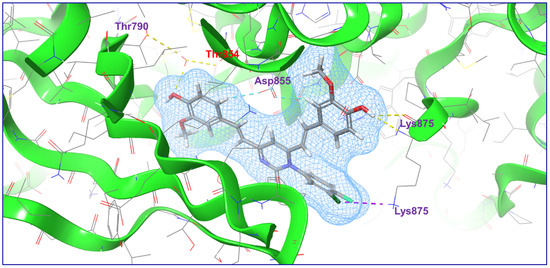
Figure 6.
The 3D interactions of ligand C3 against the active site of EGFR (binding affinity = −4.396 kcal/mol).
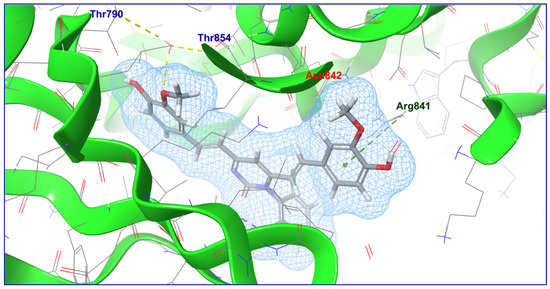
Figure 7.
The 3D interactions of ligand C2 against the active site of EGFR (binding affinity = −5.086 kcal/mol).
3. Discussion
Three new curcumin analogues (C1-C3) were reported in the current work. Curcumin and substituted phenyl urea in glacial acetic acid were stirred at 80 °C for 8 h to obtain 1-aryl-4,6-bis((E)-4-hydroxy-3-methoxystyryl)pyrimidin-2(1H)-ones (C1-C3) in good yields (75–80%). All the title compounds were characterized by analytical techniques, followed by their anticancer evaluation and molecular docking studies. One of the curcumin analogues (C2) displayed the most promising anticancer activity with a mean GP of 31.78 (% GI = 68.22). Nearly 31 cancer cell lines were found to be highly sensitive against the compound C2 with %GIs of >68. Two of the curcumin analogues (C1 and C2) displayed lethal effects on HT29 colon cancer cell lines with %GIs of 105.09 and 130.44. The anticancer activity of compound C2 was found to be better than that of curcumin and anti-EGFR drugs (gefitinib and imatinib) against CNS, melanoma, ovarian, prostate, and breast cancer cell lines, it was also found as active against all the cell lines of leukemia and breast cancer cell line panels (Table 2). The compound C2 was further studied in 5-dose assay in which GI50 values were found to be ranging from 1.31 to 4.68 µM, however, it was found to be non-selective with SR values ranging from 0.73 to 1.35. The GI50 values of compound C2 were found to be better than that of the curcumin against all nine panels of cancer cell lines. The anticancer activity of compound C2 (mean % GI = 68.22) was found to be promising more than the previously reported work [2]. Chemically altering the diketone function to produce pyrazole and primidone analogues was shown to be more promising than doing so to produce bigenelli type curcumin analogues [2,26,53,54]. Curcumin analogues with 3-chloro-4-fluoro (C3) substitution in the phenyl ring at 1-pyrimidine showed mean %GI of 14.33, while 4-chloro (C1) substitution showed mean %GI of 20.37 and 2,6-dichloro (C2) substitution showed the most promising anticancer activity with %GI of 68.22. Three types of interaction were observed for the ligands (C1-C3) including H-bond, π-cationic, and halogen bonds with a binding affinity of -4.936 to -5.117 kcal/mol. The ligands C1 and C2 bind to the EGFR active site efficiently, whereas the ligand C3 binds less efficiently. The most active compound (C2) showed H-bond interaction with residue Thr854 through the water molecule, π-cationic interaction with residue Arg841, and halogen bond interaction with the water molecule. It also showed good interaction with residues Ala743, Val726, Thr790, Lys745, Leu799, Asp800, Gly721, Leu781, Cys775, Leu844, Cys797, Ser720, and Phe723.
4. Materials and Methods
4.1. Preparation of Curcumin Analogue C1-C3
An equimolar mixture of curcumin (A1) (0.20 mmol; 73.6 mg) and substituted phenyl ureas (B1-B3) (0.20 mmol) in glacial acetic acid (10 mL) was stirred in a sand bath at 80 °C for 8 h. After completion, the reaction mixture was concentrated under a vacuum to remove excess solvent and poured into crushed ice, filtered, dried, and recrystallized with ethanol to yield compound C1-C3 [2,26].
4.1.1. 1-(4-Chlorophenyl)-4,6-bis((E)-4-hydroxy-3-methoxystyryl)pyrimidin-2(1H)-one
(C1): Mp 132–134 °C; IR (KBr) vmax: 3382 (OH), 1637 (C=O), 1558 (C=N), 1163 (O-CH3), 713 (C-Cl) cm−1; 1H NMR (400 MHz; DMSO-d6): δ 1H NMR (400 MHz; DMSO-d6): δ; 3.81 (6H, s, OCH3), 6.04 (1H, s, ArHpyrimidine), 6.71–6.75 (2H, d, J = 12.2 Hz, CH=CH), 6.79–6.81 (2H, d, J = 12.1 Hz, CH=CH), 7.12–7.13 (3H, m ArH), 7.29 (2H, s, ArH), 7.41 (2H, d, J = 6.1 Hz, ArH), 7.43 (2H, d, J = 6.1 Hz, ArH), 9.62 (2H, s, ArOH); ESI-MS: 504.2 (M+1)+ 506.1 (M+2)+.
4.1.2. 1-(2,6-Dichlorophenyl)-4,6-bis((E)-4-hydroxy-3-methoxystyryl)pyrimidin-2(1H)-one
(C2): Mp 148–150 °C; IR (KBr) vmax: 3402 (OH), 1638 (C=O), 1559 (C=N), 1153 (O-CH3), 713 (C-Cl) cm−1; 1H NMR (400 MHz; DMSO-d6): δ; 3.81 (6H, s, OCH3), 6.04 (1H, s, ArHpyrimidine), 6.71–6.75 (2H, d, J = 12.1 Hz, CH=CH), 6.79–6.81 (2H, d, J = 12.0 Hz, CH=CH), 7.12–7.16 (4H, m ArH), 7.30 (2H, s, ArH), 7.50–7.54 (3H, m, ArH), 9.62 (2H, s, ArOH); ESI-MS: 538.2 (M+1)+ 540.1 (M+2)+.
4.1.3. 1-(3-Chloro-4-fluorophenyl)-4,6-bis((E)-4-hydroxy-3-methoxystyryl)pyrimidin-2(1H)-one
(C3): Mp 164–162 °C; IR (KBr) vmax: 3382 (OH), 1638 (C=O), 1558 (C=N), 1154 (O-CH3), 875 (C-Br), 713 (C-Cl) cm−1; 1H NMR (400 MHz; DMSO-d6): δ; 3.81 (6H, s, OCH3), 6.04 (1H, s, ArHpyrimidine), 6.69–6.71 (2H, d, J = 12.0 Hz, CH=CH), 6.77–6.79 (2H, d, J = 12.1 Hz, CH=CH), 6.81–6.99 (4H, m ArH), 7.11 (2H, s, ArH), 7.22 (1H, s, ArH), 7.42–7.44 (2H, m, ArH), 9.62 (2H, s, ArOH); ESI-MS: 522.1 (M+1)+ 524.1 (M+2)+.
4.2. Anticancer Activity
The antiproliferative activity of the curcumin analogues (C1-C3) was evaluated against nine diverse panels of 59 cancer cell lines at a single dose (10 µM) and a 5-dose assay (0.001 to 100 µM) according to the National Cancer Institute (NCI US) protocol [43,44,45,46,47,48,49,50]. We explained the detailed method in our previous work [2].
4.3. Molecular Docking Studies
The molecular docking against EGFR was performed for the ligands, C1-C3. The EGFR (PDB: 2J5F) X-ray crystal structure with a resolution of 3.00 Å; R-value 0.194 (observed) was obtained from the protein data bank (https://www.rcsb.org/structure/2j5f) [55]. The ligands C1-C3 were saved as mol file and the docking was done as per the protocol reported [52].
5. Conclusions
Curcumin was successfully isolated from the ground turmeric powder and chemically modified to prepare three semi-synthetic analogues bearing pyrimidinone nucleus. All the compounds (C1-C3) were synthesized in good yields and characterized by analytical data of IR, NMR, and mass spectroscopy. The anticancer activity of curcumin analogues was evaluated in a single-dose experiment at 10 µM. The anticancer activity of compound C2 was found to be promising with %GI of 68.22 percent, and superior to curcumin, gefitinib, and imatinib against CNS, melanoma, ovarian, prostate, and breast cancer cell lines. The compound C2 displayed promising anticancer activity and has been further evaluated in 5-dose assay displayed anticancer activity with GI50 values ranging from 1.31 to 4.68 µM; however, found to be non-selective with SR values ranging from 0.73 to 1.35. The compound C2 was found to be more active than curcumin against all nine panels of cancer cell lines. Since EGFR was found to be over-expressed in a number of cancer cell lines, including those from breast, colon, non-small cell lung, renal, melanoma, ovarian, and prostate cancers we selected EGFR as a potential target and the mechanism behind the anticancer activity of the title compounds. We further studied the binding insight of our compounds (C1-C3) against the active binding site EGFR where 6-acrylamido-4-anilinoquinazoline usually bind [52]. In molecular docking studies all the ligands were found to accommodate in the active site of EGFR and the binding affinity of ligand C2 was found to be −5.086 kcal/mol. The ligand C2 exhibited three different types of interactions: H-bond (Thr790 and Thr854), π-cationic (Arg841), and aromatic H-bond (Asn842). Furthermore, the ligand C2 displayed good interaction with residues Ala743, Val726, Thr790, Lys745, Leu799, Asp800, Gly721, Leu781, Cys775, Leu844, Cys797, Ser720, and Phe723. The curcumin analogues reported in the current investigation may provide valuable therapeutic intervention for the prevention and treatment of cancer and accelerate anticancer drug discovery programs in the future.
Supplementary Materials
The following supporting information can be downloaded at: https://www.mdpi.com/article/10.3390/plants11202737/s1, Figure S1–S3: Anticancer data of compounds C1-C3 against 59 cancer cell lines., Figure S4. 3D Interaction of ligand C1 against the binding site EGFR.
Author Contributions
Conceptualization, execution; manuscript writing M.J.A. and O.A.; synthesis, M.J.A. and O.A.; molecular docking and drug design, A.A.; compilation of data and result, M.J.A., M.Y. and O.A.; writing—review and editing, M.A.B., A.S.A.A., O.A., M.Y. and S.; supervision, M.J.A.; funding acquisition, M.Y. All authors have read and agreed to the published version of the manuscript.
Funding
The research was supported by Taif University Researchers Supporting Project Number (TURSP-2020/293).
Institutional Review Board Statement
Not applicable.
Informed Consent Statement
Not applicable.
Data Availability Statement
The authors confirm that the data supporting the study’s findings are included in the article and its supplementary information.
Acknowledgments
The research was supported by Taif University Researchers Supporting Project Number (TURSP-2020/293).
Conflicts of Interest
The authors declared no conflict of interest.
References
- Koehn, F.E.; Carter, G.T. The evolving role of natural products in drug discovery. Nat. Rev. Drug Discov. 2005, 4, 206–220. [Google Scholar] [CrossRef] [PubMed]
- Ali, A.; Ali, A.; Tahir, A.; Bakht, M.A.; Salahuddin; Ahsan, M.J. Molecular Engineering of Curcumin, an Active Constituent of Curcuma longa L. (Turmeric) of the Family Zingiberaceae with Improved Antiproliferative Activity. Plants 2021, 10, 1559. [Google Scholar] [CrossRef]
- Mishra, B.B.; Tiwari, V.K. Natural products: An evolving role in future drug discovery. Eur. J. Med. Chem. 2011, 46, 4769–4807. [Google Scholar] [CrossRef] [PubMed]
- Newman, D.J.; Cragg, G.M. Natural products as sources of new drugs from 1981 to 2014. J. Nat. Prod. 2016, 79, 629–661. [Google Scholar] [CrossRef] [PubMed]
- Conlin, A.; de Azambuja, E.; Lago, L.D. Current perspectives of epothilones in breast cancer. Eur. J. Cancer 2008, 44, 341–352. [Google Scholar]
- Grossman, S.A.; Carson, K.A.; Phuphanich, S.; Batchelor, T.; Peereboom, D.; Nabors, L.B.; Lesser, G.; Hausheer, F. Phase I and pharmacokinetic study of karenitecin in patients with recurrent malignant gliomas. Neuro-oncology 2008, 10, 608–616. [Google Scholar] [CrossRef] [PubMed]
- Butler, M.S. Natural products to drugs: Natural product-derived compounds in clinical trials. Nat. Prod. Rep. 2008, 25, 475. [Google Scholar] [CrossRef]
- Sessa, C.; Cresta, S.; Cerny, T.; Baselga, J.; Caremoli, E.R.; Malossi, A.; Hess, D.; Trigo, J.; Zucchetti, M.; D’Incalci, M.; et al. Concerted escalation of dose and dosing duration in a phase I study of the oral camptothecin gimatecan (ST1481) in patients with advanced solid tumors. Annal. Oncol. 2007, 18, 561–568. [Google Scholar] [CrossRef]
- Sergent, J.M.; Elgie, A.W.; Williamson, C.J.; Hill, B.T. Ex vivo effects of the dual topoisomerase inhibitor tafluposide (F 11782) on cells isolated from fresh tumor samples taken from patients with cancer. Anti-Cancer Drug 2003, 14, 467–473. [Google Scholar] [CrossRef]
- David-Cordonnier, M.H.; Laine, W.; Lansiaux, A.; Kouach, M.; Briand, G.; Pierré, A.; Hickman, J.A.; Bailly, C. Alkylation of Guanine in DNA by S23906-1, a Novel Potent Antitumor Compound Derived from the Plant Alkaloid Acronycine. Biochemistry 2002, 41, 9911–9920. [Google Scholar] [CrossRef]
- Tron, G.C.; Pirali, T.; Sorba, G.; Pagliai, F.; Bussacca, S.; Genzzani, A.A. Medicinal Chemistry of Combretastatin A4: Present and Future Directions. J. Med. Chem. 2006, 49, 3033–3044. [Google Scholar] [CrossRef] [PubMed]
- Pettit, G.R.; Lippert, J.W.; Naraynan, V.R.; Varma, R.; Simpson, M.J.; Boyd, M.R.; Rener, G.A.; Bansal, N. Antineoplastic agents 322. synthesis of combretastatin A-4 prodrugs. Anti-Cancer Drug Des. 1995, 10, 299–309. [Google Scholar]
- Grossman, S.A.; Ye, X.; Peereboom, D.; Rosenfeld, M.R.; Mikkelsen, T.; Supko, J.G.; Desideri, S. Phase I study of terameprocol in patients with recurrent high-grade glioma. Neuro. Oncol. 2012, 14, 511–517. [Google Scholar] [CrossRef] [PubMed]
- Taylor, C.G.; Feitelson, A.K.; Taylor, D.D. Inhibitory effect of genistein and daidzein on ovarian cancer cell growth. Anticancer Res. 2004, 24, 795–800. [Google Scholar]
- Mishra, S.; Karmodiya, K.; Surolia, N.; Surolia, A. Synthesis and exploration of novel curcumin analogues as anti-malarial agents. Bioorg. Med. Chem. 2008, 16, 2894–2902. [Google Scholar] [CrossRef] [PubMed]
- Lal, J.; Gupta, S.K.; Thavaselvam, D.; Agrawal, D.D. Design, synthesis, synergistic antimicrobial activity and cytotoxicity of 4-aryl substituted 3,4-dihydropyrimidinones of curcumin. Bioorg. Med. Chem. 2012, 22, 2872–2876. [Google Scholar] [CrossRef]
- Sahu, P.K.; Sahu, P.K.; Gupta, S.K.; Thavaselvam, D.; Agarwal, D.D. Synthesis and evaluation of antimicrobial activity of 4H-pyrimido[2,1-b]benzothiazole, pyrazole and benzylidene derivatives of curcumin. Eur. J. Med. Chem. 2012, 54, 366–378. [Google Scholar] [CrossRef]
- Saja, K.; Babu, M.S.; Karunagaran, D.; Sudhakaran, P.R. Anti-inflammatory effect of curcumin involves down regulation of MMP-9 in blood mononuclear cells. Int. Immunopharm. 2007, 7, 1659–1667. [Google Scholar] [CrossRef] [PubMed]
- Singh, R.K.; Rai, D.; Yadav, D.; Bhargava, A.; Balzarini, J.; DeClercq, E. Synthesis, antibacterial and antiviral properties of curcumin bioconjugates bearing dipeptide, fatty acids and folic acid. Eur. J. Med. Chem. 2010, 45, 1078–1086. [Google Scholar] [CrossRef] [PubMed]
- Zhichang, L.; Yinghong, W.; Yuanqin, Z.; Qinxiang, X. Synthesis and antibacterial activities of N-Substituted pyrazole curcumin derivatives. Chin. J. Org. Chem. 2012, 32, 1487–1492. [Google Scholar]
- Lee, W.H.; Loo, C.Y.; Bebawy, M.; Luk, F.; Mason, R.S.; Rohanizadeh, R. Curcumin and its Derivatives: Their Application in Neuropharmacology and Neuroscience in the 21st Century. Curr Neuropharmacol. 2013, 11, 338–378. [Google Scholar] [CrossRef] [PubMed]
- Yadav, I.S.; Nandekar, P.P.; Shrivastava, S.; Sanganwar, A.; Choudhry, A.; Agarwal, S.M. Ensemble docking and molecular dynamics identify knoevenagel curcumin derivatives with potent anti-EGFR activity. Gene 2014, 539, 82–90. [Google Scholar] [CrossRef] [PubMed]
- Vyas, A.; Dandawate, P.; Padhye, S.; Ahmad, A.; Sarkar, F. Perspectives on new synthetic curcumin analogs and their potential anticancer properties. Curr. Pharm. Des. 2013, 19, 2047–2069. [Google Scholar] [PubMed]
- Balaji, S.N.; Ahsan, M.J.; Jadav, S.S.; Trivedi, V. Molecular modeling, synthesis and antimalarial potentials of curcumin analogues containing heterocyclic ring. Arab. J. Chem. 2019, 12, 2492–2500. [Google Scholar] [CrossRef]
- Rodrigues, F.C.; Kumar, N.V.A.; Thakur, G. The potency of heterocyclic curcumin analogues: An evidence-based review. Pharmacol. Res. 2012, 166, 105489. [Google Scholar] [CrossRef] [PubMed]
- Ahsan, M.J.; Khalilullah, H.; Yasmin, S.; Jadav, S.S.; Govindasamy, J. Synthesis, characterisation, and in vitro anticancer activity of curcumin analogues bearing pyrazole/pyrimidine ring targeting EGFR tyrosine kinase. BioMed Res. Int. 2013, 2013, 239354. [Google Scholar] [CrossRef] [PubMed]
- Lhouvum, K.; Balaji, S.N.; Ahsan, M.J.; Trivedi, V. Plasmodium falciparum PFI1625c offers an opportunity to design potent anti-malarials: Biochemical characterization and testing potentials in drug discovery. Acta Trop. 2019, 191, 116–128. [Google Scholar] [CrossRef] [PubMed]
- Ahsan, M.J.; Sharma, S. Design, Synthesis and Anti-HIV Activity of Curcumin Analogues. In Lambert Academic Publishing; Lambert Academic Publishing: Saarbrücken, Germany, 2015; ISBN 978-3-659-75001-4. [Google Scholar]
- Sung, H.; Ferley, J.; Siegel, R.L.; Laversanne, M.; Soerjomartaram, I.; Jemal, A.; Bray, F. Global cancer statistics 2020: GLOBOCAN estimates of incidence and mortality worldwide for 36 cancers in 185 countries. CA Cancer J. Clin. 2021, 71, 209–249. [Google Scholar] [CrossRef]
- Rayan, A.; Raiyn, J.; Falah, M. Nature is the best source of anticancer drugs: Indexing natural products for their anticancer bioactivity. PLoS ONE 2017, 12, e0187925. [Google Scholar] [CrossRef]
- Xie, Y.H.; Chen, Y.X.; Fang, J.Y. Comprehensive review of targeted therapy for colorectal cancer. Signal Transduct. Target Ther. 2020, 5, 22. [Google Scholar] [CrossRef] [PubMed]
- Wee, P.; Wang, Z. Epidermal Growth Factor Receptor Cell Proliferation Signaling Pathways. Cancers 2017, 9, 52. [Google Scholar] [CrossRef] [PubMed]
- Hoadley, K.A.; Weigman, V.J.; Fan, C.; Sawyer, L.R.; He, X.; Troester, M.A.; Sartor, C.I.; Rieger-House, T.; Bernard, P.S.; Carey, L.A.; et al. EGFR associated expression profiles vary with breast tumor subtype. BMC Genom. 2007, 8, 258. [Google Scholar] [CrossRef]
- Xu, H.; Yu, Y.; Marciniak, D.; Rishi, A.K.; Sarkar, F.H.; Kucuk, O.; Majumdar, A.P.N. Epidermal growth factor receptor (EGFR)–related protein inhibits multiple members of the EGFR family in colon and breast cancer cells. Mol. Cancer Ther. 2005, 4, 435–442. [Google Scholar] [CrossRef] [PubMed]
- Rusnak, D.W.; Alligood, K.J.; Mullin, R.J.; Spehar, G.M.; Arenas-Elliott, C.; Martin, A.M.; Degenhardt, Y.; Rudolph, S.K.; Jr Haws, T.F.; Hudson-Curtis, B.L.; et al. Assessment of epidermal growth factor receptor (EGFR, ErbB1) and HER2 (ErbB2) protein expression levels and response to lapatinib (Tykerb®, GW572016) in an expanded panel of human normal and tumour cell lines. Cell Prolif. 2007, 40, 580–594. [Google Scholar] [CrossRef]
- Mohamady, S.; Galal, M.; Eldehna, W.M.; Gutierrez, D.C.; Ibrahim, H.S.; Elmazar, M.M.; Ali, H.I. Dual Targeting of VEGFR2 and C-Met Kinases via the Design and Synthesis of Substituted 3-(Triazolo-thiadiazin-3-yl)indolin-2-one Derivatives as Angiogenesis Inhibitors. ACS Omega 2020, 5, 18872–18886. [Google Scholar] [CrossRef] [PubMed]
- Sogabe, S.; Kawakita, Y.; Igaki, S.; Iwata, H.; Miki, H.; Cary, D.R.; Takagi, T.; Takagi, S.; Ohta, Y.; Ishikawa, T. Structure-Based Approach for the Discovery of Pyrrolo[3,2-d]pyrimidine-Based EGFR T790M/L858R Mutant Inhibitors. ACS Med. Chem. Lett. 2013, 4, 201–205. [Google Scholar] [CrossRef] [PubMed]
- Merla, A.; Goel, S. Novel Drugs Targeting the Epidermal Growth Factor Receptor and Its Downstream Pathways in the Treatment of Colorectal Cancer: A Systematic Review. Chemother. Res. Prac. 2012, 2012, 387172. [Google Scholar] [CrossRef] [PubMed]
- Xu, M.J.; Johnson, D.E.; Grandis, J.R. EGFR-Targeted Therapies in the Post-Genomic Era. Cancer Metastasis Rev. 2017, 36, 463–473. [Google Scholar] [CrossRef] [PubMed]
- Anderson, A.M.; Mitchell, M.S.; Mohan, R.S. Isolation of Curcumin from Turmeric. J. Chem. Edu. 2000, 77, 59–60. [Google Scholar] [CrossRef]
- Ahsan, M.J.; Meena, R.; Dubey, S.; Khan, V.; Manda, S.; Jadav, S.S.; Sharma, P.; Geesi, M.H.; Hassan, M.Z.; Bakht, M.A.; et al. Synthesis and biological potentials of some new 1,3,4-oxadiazole analogues. Med. Chem. Res. 2018, 27, 864–883. [Google Scholar] [CrossRef]
- Ahsan, M.J. Rationale Design, Synthesis And In Vitro Anticancer Activity of New 2,5-Disubstituted-1,3,4-Oxadiazole Analogues. ChemistrySelect 2016, 1, 4713–4720. [Google Scholar] [CrossRef]
- DTP Developmental Therapeutic Programs. Available online: http://dtp.nci.nih.gov (accessed on 19 August 2022).
- Monks, A.; Scudiero, D.; Skehan, P.; Shoemaker, R.; Paull, K.; Vistica, D.; Hose, C.; Langley, J.; Cronise, P.; Vaigro-Wolff, A.; et al. Feasibility of a high flux anticancer drug screening using a diverse panel of cultured human tumor cell lines. J. Nat. Cancer Inst. 1991, 83, 757–766. [Google Scholar] [CrossRef]
- Boyd, M.R.; Paull, K.D. Some practical considerations and applications of the National Cancer Institute in vitro anticancer drug discovery screen. Drug Dev. Res. 1995, 34, 91–109. [Google Scholar] [CrossRef]
- Shoemaker, R.H. The NCI60 human tumour cell line anticancer drug screen. Nat. Rev. Cancer 2006, 6, 813–823. [Google Scholar] [CrossRef]
- Corona, P.; Carta, A.; Loriga, M.; Vitale, G.; Paglietti, G. Synthesis and in vitro antitumor activity of new quinoxaline derivatives. Eur. J. Med. Chem. 2009, 44, 1579–1591. [Google Scholar] [CrossRef]
- Grever, M.R.; Schepartz, S.A.; Chabner, B.A. The national cancer institute: Cancer drug discovery and development program. Sem. Oncol. 1992, 19, 622–638. [Google Scholar]
- Acton, E.M.; Narayanan, V.L.; Risbood, P.A.; Shoemaker, R.H.; Vistica, D.T.; Boyd, M.R. Anticancer Specificity of Some Ellipticinium Salts against Human Brain Tumors in vitro. J. Med. Chem. 1994, 37, 2185–2189. [Google Scholar] [CrossRef] [PubMed]
- Alley, M.C.; Scudiero, D.A.; Monks, A.; Hursey, M.L.; Czerwinski, M.J.; Fine, D.L.; Abbott, B.J.; Mayo, J.G.; Shoemaker, R.H.; Boyd, M.R. Feasibility of drug screening with panels of human tumor cell lines using a microculture tetrazolium assay. Cancer Res. 1998, 48, 589–601. [Google Scholar]
- Rostom, S.A.F. Synthesis and in vitro antitumor evaluation of some indeno[1,2-c]pyrazol(in)es substituted with sulfonamide, sulfonylurea(-thiourea) pharmacophores, and some derived thiazole ring systems. Bioorganic Med. Chem. 2006, 14, 6475–6485. [Google Scholar] [CrossRef] [PubMed]
- Blair, J.A.; Rauh, D.; Kung, C.; Yun, C.H.; Fan, Q.; Rode, H.; Zhang, C.; Eck, M.J.; Weiss, W.A.; Shokat, K.M. Structure-guided development of affinity probes for tyrosine kinases using chemical genetics. Nat. Chem. Bio. 2007, 3, 229–238. [Google Scholar] [CrossRef] [PubMed]
- Ahsan, M.J.; Choudhary, K.; Jadav, S.S.; Yasmin, S.; Ansari, M.Y.; Sreenivasulsu, R. Synthesis, anticancer activity and molecular docking studies of curcumin analogues bearing pyrazole ring. Med. Chem. Res. 2015, 24, 4166–4180. [Google Scholar] [CrossRef]
- Sharma, R.; Singh, S.; Yasmin, S.; Bhatia, S.; Khalilullah, H.; Ahsan, M.J. Simple, efficient, and improved synthesis of Biginelli-type compounds of curcumin as anticancer agents. Med. Chem. Res. 2015, 24, 636–644. [Google Scholar] [CrossRef]
- X-ray Crystallographic Structure of EGFR. Available online: https://www.rcsb.org/structure/2j5f (accessed on 10 September 2022).
Publisher’s Note: MDPI stays neutral with regard to jurisdictional claims in published maps and institutional affiliations. |
© 2022 by the authors. Licensee MDPI, Basel, Switzerland. This article is an open access article distributed under the terms and conditions of the Creative Commons Attribution (CC BY) license (https://creativecommons.org/licenses/by/4.0/).
